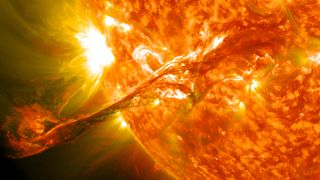
The sun is always showering Earth with a mist of magnetized particles known as solar wind. For the most part, our planet's magnetic shield blocks this electric wind from doing any real damage to Earth or its inhabitants, instead sending those particles skittering toward the poles and leaving behind a pleasant aurora in their wake.
But sometimes, every century or so, that wind escalates into a full-blown solar storm — and, as new research presented at the SIGCOMM 2021 data communication conference warns, the results of such extreme space weather could be catastrophic to our modern way of life.
In short, a severe solar storm could plunge the world into an "internet apocalypse" that keeps large swaths of society offline for weeks or months at a time, Sangeetha Abdu Jyothi, an assistant professor at the University of California, Irvine, wrote in the new research paper. (The paper has yet to appear in a peer-reviewed journal).
"What really got me thinking about this is that with the pandemic we saw how unprepared the world was. There was no protocol to deal with it effectively, and it's the same with internet resilience," Abdu Jyothi told WIRED. "Our infrastructure is not prepared for a large-scale solar event."
Part of the problem is that extreme solar storms (also called coronal mass ejections) are relatively rare; scientists estimate the probability of an extreme space weather directly impacting Earth to be between 1.6% to 12% per decade, according to Abdu Jyothi's paper.
In recent history, only two such storms have been recorded — one in 1859 and the other in 1921. The earlier incident, known as the Carrington Event, created such a severe geomagnetic disturbance on Earth that telegraph wires burst into flame, and auroras — usually only visible near the planet's poles — were spotted near equatorial Colombia. Smaller storms can also pack a punch; one in March 1989 blacked out the entire Canadian province of Quebec for nine hours. READ MIRE